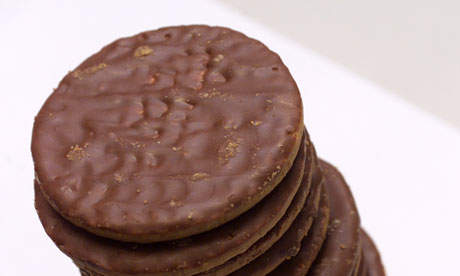
So-called "low fat" foods can contain a similar number of calories to the standard versions – and in some cases contain even more sugar, according to a study by a consumer watchdog.
The investigation by Which? found that as many as six out of 10 consumers eat low-fat and light foods several times a week believing that they are a healthier option and can help them to lose weight. But its "snapshot sample" of 12 low-fat, reduced and light products from supermarkets compared with their standard counterparts found minimal differences in calorie content.
Among the foods singled out are a standard McVitie's chocolate digestive, which contains 85 calories, compared with 77 in the "light" version – a difference of just eight calories.
A Tesco low-fat yogurt has more calories per pot – 130 – compared with the Activia standard yoghurt, containing 123 calories. The Tesco yogurt also contained more sugar – 20.2g (equivalent to more than four teaspoons) per pot rather than 16.9g in the Activia version.
Which? said its research also uncovered misconceptions among consumers about what the terms "reduced fat" and "light" mean. Products labelled with these terms only have to contain 30% less fat than the standard version, yet only 16% of people surveyed understood this.
Labelling regulations define low fat as containing less than 3% fat, the terms reduced fat, light and lite mean 30% less fat than the standard or original product, and more than 20g of fat per 100g makes a product high in fat. More than 5g saturated fat per 100g means it is high in saturated fat.Which? executive director Richard Lloyd said: "Consumers are choosing 'low-fat' and 'light' options believing them to be a healthier choice, but our research has found that in many cases they're just not living up to their healthy image. Our advice to consumers is to read the nutritional labels carefully."
Which? has been campaigning for the supermarkets to add clearer labelling to packaging so consumers can make a more informed choice about what they eat. It is calling on Morrisons and Iceland, the two remaining supermarkets yet to adopt the traffic light labelling system, to do so as soon as possible. In August Tesco backed down and announced it would develop a "hybrid" labelling system incorporating both traffic lights and its long-favoured GDA system showing "guideline daily amounts" without colours.
A Tesco spokesperson said of its yogurt product: "We take seriously our responsibility to help our customers make healthy choices. Our products display clear nutritional information on the front of the packaging, and we always act in accordance with the strict rules around the use of words such as reduced or light."
United Biscuits, which makes the McVitie's chocolate digestive, said the report was misleading about its products. A spokesman said: "While it focused on the fact that the Lights variant of the McVitie's chocolate digestive had only eight fewer calories per biscuit than the standard product, it ignored the fact that the Lights version had 30% less fat.
"It also wrongly suggested that the fat reduction was achieved by reducing the amount of chocolate on the Light variant – this is not the case. The fat reduction has been achieved through changes to the biscuit dough recipe."
Rebecca Smithers

